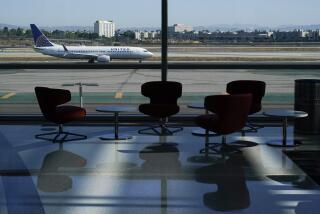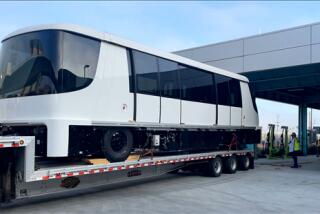LAX’s Bradley Terminal project cost heads skyward
The cost of expanding a key terminal at the center of Los Angeles International Airport’s modernization plan has increased from about $1.4 billion to almost $2 billion.
But airport officials say the overall $4.1-billion modernization program, as well as the now more-expensive Tom Bradley International Terminal, are still on schedule and within budget because of a built-in contingency fund and cost savings achieved on other projects in the revitalization effort.
“With regards to scheduling, all projects find it challenging to stay on schedule,” said Deputy Airport Director Roger Johnson. “But every day we continue to make progress. At this point in time we are on schedule.”
Johnson said he was not concerned about the Bradley’s rising costs, which he attributed mainly to additions to the project. Not counting the changes, he said, the project is still within its 2009 budget of $1.545 billion.
The improvements, designed to restore the airport’s reputation as the premier international gateway on the West Coast, include wider taxiways, new escalators and elevators, remodeled passenger facilities and a rebuilt central utility plant to provide heating and air conditioning throughout the terminal complex.
At the Bradley, about a million square feet will be added and 18 gates will be built, six more than the facility now has. Plans call for two new concourses with larger, more comfortable areas for passengers and a soaring great hall with tiered areas for upscale dining and shopping. Baggage claim and the federal inspection station will be enlarged to reduce wait times for international travelers.
Completed so far are a center taxiway to improve safety between the airport’s two southern runways and a $737-million remodel of the Bradley’s main building, including an automated system to move luggage to screening areas and aircraft.
Airport officials say the first of the current projects should be completed in September, when a gate designed to accommodate Airbus A380s, the largest passenger plane in service, is scheduled to open on the north side of the Bradley.
All the west-side gates and the terminal’s great hall are scheduled to be finished next spring. The Bradley’s old concourses are set to be torn down in 2014 so the east gates of the new complex can open. The central utility plant, which will provide heating and air-conditioning to every terminal, is scheduled to go into operation in August 2014.
Since 2009, the estimated cost of improving the Bradley has increased from $1.38 billion to $1.97 billion, airport records show. The increase is a result of change orders, the shifting of two smaller projects in the overall program to the Bradley account, and two revisions last month that bumped up the budget by almost $233 million.
Added was a four-level structure that will connect to Terminal 4, the American Airlines facility next door. The floors will house federal inspection stations for luggage and passengers, a passageway for travelers between the Bradley and Terminal 4, counters to recheck baggage and access to a bus port.
Officials also want to make cosmetic changes to enhance the front of the Bradley and replace restaurants in the mezzanine with more security checkpoints for passengers.
Though Johnson says money from cost-saving measures will be available to replenish the contingency fund, some uncertainty remains. There are roughly two more years of construction, and airport officials have yet to determine the cost of fixing the Bradley’s $140-million baggage screening system that has been underperforming.
The facility, which relies on a complicated array of conveyors to feed bags into and out of security scanners, was supposed to screen 3,240 pieces of luggage an hour but has been processing only between 1,500 and 1,800. The system is housed in a 45,000-square-foot annex next to the Bradley.
More to Read
Sign up for Essential California
The most important California stories and recommendations in your inbox every morning.
You may occasionally receive promotional content from the Los Angeles Times.











